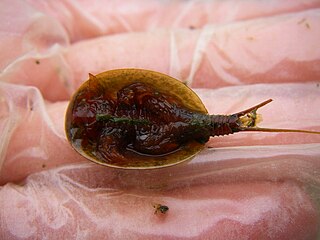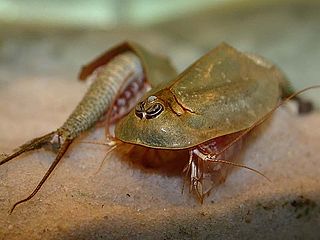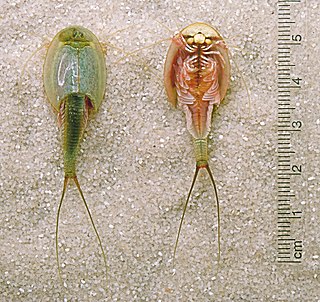 W
WThe order Notostraca, containing the single family Triopsidae, is a group of crustaceans known as tadpole shrimp or shield shrimp. The two genera, Triops and Lepidurus, are considered living fossils, with similar forms having existed since the Devonian. They have a broad, flat carapace, which conceals the head and bears a single pair of compound eyes. The abdomen is long, appears to be segmented and bears numerous pairs of flattened legs. The telson is flanked by a pair of long, thin caudal rami. Phenotypic plasticity within taxa makes species-level identification difficult, and is further compounded by variation in the mode of reproduction. Notostracans are omnivores living on the bottom of temporary pools and shallow lakes.
 W
WChenops is an extinct genus of notostracan which existed in the Yixian Formation, Inner Mongolia, and the Jehol fauna of China during the early Cretaceous period. The genus was erected by Thomas A. Hegna and Ren Dong in 2010 to describe the Yixian species, Chenops yixianensis. A second species, originally described as "Prolepidurus oblongus", from the Jehol fauna, was redescribed as C. oblongus.
 W
WJeholops is an extinct genus of notostracan which existed in the Yixian Formation, inner Mongolia, China during the early Cretaceous period. It was described by Thomas A. Hegna and Ren Dong in 2010, and the only species is Jeholops hongi.
 W
WLepidurus is a genus of small crustaceans in the order Notostraca. It is the larger of the two extant genera of the tadpole shrimps, the other being Triops. They are commonly found in vernal pools and survive dry periods with the help of long lasting resting eggs.
 W
WLepidurus apus, commonly known as a tadpole shrimp, is a notostracan in the family Triopsidae, one of a lineage of shrimp-like crustaceans that have had a similar form since the Triassic period and are considered living fossils. This species is cosmopolitan, inhabiting temporary freshwater ponds over much of the world, and the most widespread of the tadpole shrimps. Like other notostracans, L. apus has a broad carapace, long segmented abdomen, and large numbers of paddle-like legs. It reproduces by a mixture of sexual reproduction and self-fertilisation of females.
 W
WLepidurus arcticus is a species of tadpole shrimp which inhabits both ephemeral pools and permanent freshwater lakes of Norway, Greenland, Finland, Sweden, Svalbard, Iceland, Russia and the Kuril Islands.
 W
WLepidurus packardi, known by the common name vernal pool tadpole shrimp, is a rare species of tadpole shrimp (Notostraca).
 W
WTriops is a genus of small crustaceans in the order Notostraca. The long-lasting resting eggs of several species of Triops are commonly sold in kits as a pet. The animals hatch upon contact with fresh water. Most adult-stage Triops have a life expectancy of up to 90 days and can tolerate a pH range of 6–10. In nature, they often inhabit temporary pools.
 W
WTriops australiensis, sometimes referred to as a shield shrimp, is an Australian species of the tadpole shrimp Triops.
 W
WTriops cancriformis, or tadpole shrimp, is a species of tadpole shrimp found in Europe to the Middle East and India.
 W
WTriops granarius is a species of tadpole shrimp with a broad distribution from Africa and the Middle East to China and Japan, although there are indications that it, as presently defined, is a species complex. They have elongated bodies and large flaps. Triops granarius can be kept as pets in home aquaria. Their life expectancy is up to 90 days, and in that time they can grow more than 6 cm in length.
 W
WTriops longicaudatus is a freshwater crustacean of the order Notostraca, resembling a miniature horseshoe crab. It is characterized by an elongated, segmented body, a flattened shield-like brownish carapace covering two thirds of the thorax, and two long filaments on the abdomen. The genus name Triops comes from Ancient Greek ὤψ or ṓps, meaning "eye" prefixed with Latin tri-, "three", in reference to its three eyes. Longicaudatus is a Latin neologism combining longus ("long") and caudatus ("tailed"), referring to its long tail structures. Triops longicaudatus is found in freshwater ponds and pools, often in places where few higher forms of life can exist.
 W
WTriops newberryi is a species of Triops found on the western coast of North America, commonly in valleys throughout the states of Washington, Oregon, California, and small areas of Nevada, Utah, New Mexico, and Mexico, with at least one disjunct population in Kansas. They are found in vast numbers though in the Coachella Valley in California. T. newberryi has been reported to have potential as a biocontrol agent for larval mosquitoes breeding in seasonally-flooded habitats. T. newberryi is genetically distinct from T. longicaudatus, the dominant species in the Central United States.